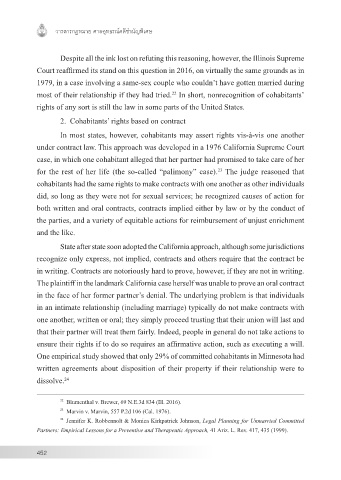Page 454 - วารสารกฎหมาย ศาลอุทธรณ์คดีชํานัญพิเศษ
P. 454
วารสารกฎหมาย ศาลอุทธรณ์คดีชำานัญพิเศษ
Despite all the ink lost on refuting this reasoning, however, the Illinois Supreme
Court reaffirmed its stand on this question in 2016, on virtually the same grounds as in
1979, in a case involving a same-sex couple who couldn’t have gotten married during
most of their relationship if they had tried. In short, nonrecognition of cohabitants’
22
rights of any sort is still the law in some parts of the United States.
2. Cohabitants’ rights based on contract
In most states, however, cohabitants may assert rights vis-à-vis one another
under contract law. This approach was developed in a 1976 California Supreme Court
case, in which one cohabitant alleged that her partner had promised to take care of her
for the rest of her life (the so-called “palimony” case). The judge reasoned that
23
cohabitants had the same rights to make contracts with one another as other individuals
did, so long as they were not for sexual services; he recognized causes of action for
both written and oral contracts, contracts implied either by law or by the conduct of
the parties, and a variety of equitable actions for reimbursement of unjust enrichment
and the like.
State after state soon adopted the California approach, although some jurisdictions
recognize only express, not implied, contracts and others require that the contract be
in writing. Contracts are notoriously hard to prove, however, if they are not in writing.
The plaintiff in the landmark California case herself was unable to prove an oral contract
in the face of her former partner’s denial. The underlying problem is that individuals
in an intimate relationship (including marriage) typically do not make contracts with
one another, written or oral; they simply proceed trusting that their union will last and
that their partner will treat them fairly. Indeed, people in general do not take actions to
ensure their rights if to do so requires an affirmative action, such as executing a will.
One empirical study showed that only 29% of committed cohabitants in Minnesota had
written agreements about disposition of their property if their relationship were to
dissolve. 24
22 Blumenthal v. Brewer, 69 N.E.3d 834 (Ill. 2016).
23 Marvin v. Marvin, 557 P.2d 106 (Cal. 1976).
24 Jennifer K. Robbennolt & Monica Kirkpatrick Johnson, Legal Planning for Unmarried Committed
Partners: Empirical Lessons for a Preventive and Therapeutic Approach, 41 Ariz. L. Rev. 417, 435 (1999).
452

